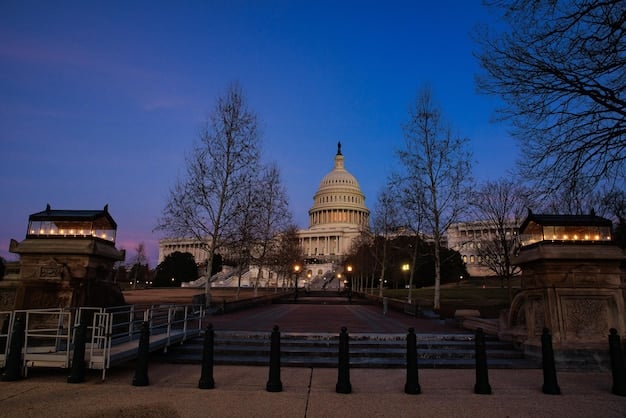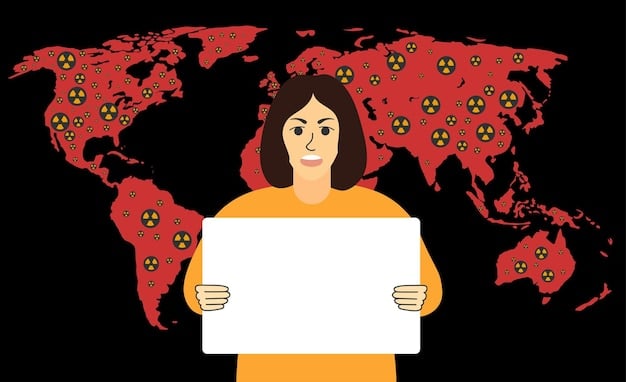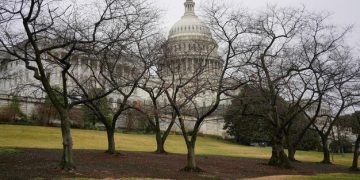US Human Rights Policy: Balancing Morality and Economic Interests

US policy on human rights navigates the complex terrain of foreign relations, striving to balance promoting democratic values and upholding human rights standards globally while safeguarding its own economic and strategic interests.
The landscape of US policy on human rights: balancing economic interests with moral obligations in foreign relations is complex and ever-evolving. This article dives into this critical aspect of US foreign policy, exploring its historical context, current challenges, and future directions, offering a comprehensive overview for anyone seeking to understand this intricate balance.
The Historical Context of US Human Rights Policy
Understanding the historical context is crucial to grasping the present state of US human rights policy. The evolution of this policy reflects shifting global dynamics, domestic priorities, and evolving conceptions of human rights.
From its inception, the United States has grappled with the tension between its ideals of liberty and equality and its pursuit of national interests.
Early Influences and the Cold War
The foundation of US human rights policy can be traced back to the post-World War II era, particularly the Universal Declaration of Human Rights in 1948. The Cold War further shaped this policy, as the US sought to differentiate itself from the Soviet Union.
- Universal Declaration of Human Rights: Served as a baseline for international human rights standards.
- Cold War Dichotomy: Highlighted the ideological battle between democracy and communism.
- Strategic Alliances: Required balancing human rights concerns with geopolitical considerations.
The US often prioritized strategic alliances over strict adherence to human rights principles, leading to criticisms and debates about the consistency of its policy.

Economic Interests vs. Moral Imperatives
A central challenge in US human rights policy lies in the constant negotiation between economic interests and adherence to moral imperatives. These two forces often pull in opposite directions, creating dilemmas for policymakers.
The US government is often pressured to prioritize economic relationships with countries that may have questionable human rights records. Finding the optimal balance is a complex task.
Trade Agreements and Human Rights
Trade agreements are a significant arena where economic interests and human rights considerations intersect. The US often uses trade agreements to promote labor standards and human rights, but this is not always the primary focus.
These agreements can include provisions related to child labor, forced labor, and freedom of association, but the enforcement of these provisions varies considerably.
- Trade Conditionality: Attaching human rights requirements to trade agreements.
- Enforcement Challenges: Ensuring compliance with human rights provisions.
- Economic Leverage: Using trade as a tool to influence human rights practices.
Despite the potential for positive impact, critics argue that economic benefits frequently outweigh human rights concerns in US trade policy.
Current US Human Rights Policy: An Overview
Understanding the current state of US human rights policy requires examining the various instruments and mechanisms employed, as well as the priority areas of focus. The strategies used today reflect both continuity and change from previous administrations.
The Biden administration has signaled a renewed commitment to human rights as a central pillar of US foreign policy.

Key Instruments and Mechanisms
The US employs a range of tools to promote human rights abroad, including sanctions, diplomacy, and foreign aid. These instruments are often used in combination to achieve specific objectives.
Sanctions are frequently imposed on individuals and entities responsible for human rights abuses, while diplomatic efforts aim to encourage positive change through dialogue and negotiation.
- Sanctions and Visa Restrictions: Targeting human rights abusers directly.
- Diplomacy and Dialogue: Engaging in negotiations to promote reforms.
- Foreign Aid and Assistance: Supporting civil society organizations and human rights defenders.
These mechanisms are most effective when deployed strategically and in coordination with other countries and international organizations.
Challenges and Criticisms of US Policy
US human rights policy is not without its critics, who point to inconsistencies, double standards, and a perceived prioritization of economic and strategic interests over genuine human rights concerns. These criticisms often focus on specific cases and regions where the US has been accused of overlooking abuses or supporting regimes with questionable records.
One frequent criticism revolves around the selective application of human rights principles.
Inconsistencies and Double Standards
Critics argue that the US applies different standards to different countries, often depending on strategic or economic considerations. This perception of inconsistency undermines the credibility of US human rights policy.
For example, the US may be more vocal in condemning human rights abuses in countries that are geopolitical rivals while remaining relatively silent on abuses in allied nations.
- Strategic Alliances: Balancing human rights concerns with geopolitical priorities.
- Economic Interests: Prioritizing trade and investment over human rights conditions.
- Geopolitical Considerations: Tailoring human rights policy to suit strategic objectives.
Addressing these inconsistencies is crucial to restoring trust in US human rights policy.
The Role of International Organizations
International organizations play a crucial role in shaping and implementing US human rights policy. These organizations provide platforms for dialogue, monitoring, and enforcement, helping to ensure that human rights standards are upheld globally.
The US often works in conjunction with international bodies to address human rights abuses and promote democratic values.
Cooperation and Collaboration
The US engages with a variety of international organizations, including the United Nations, the Organization of American States, and the European Union, to advance human rights objectives. This cooperation can take many forms, from joint statements and resolutions to coordinated sanctions and peacekeeping operations.
For example, the US has worked closely with the UN Human Rights Council to investigate and condemn human rights abuses in various countries.
- United Nations: Participating in human rights mechanisms and treaty bodies.
- Regional Organizations: Partnering with organizations like the OAS and the EU.
- Multilateral Initiatives: Supporting initiatives to promote democracy and human rights.
Effective engagement with these organizations is essential for amplifying the impact of US human rights policy.
Future Directions and Recommendations
Looking ahead, there are several key areas where US human rights policy can be strengthened and improved. These include enhancing accountability, promoting transparency, and prioritizing human rights in all aspects of foreign policy.
A more consistent and principled approach to human rights is essential for restoring US credibility on the global stage.
Enhancing Accountability and Transparency
One of the most important steps the US can take to improve its human rights policy is to enhance accountability and transparency. This includes holding human rights abusers accountable for their actions and ensuring that US policies are transparent and subject to public scrutiny.
For example, the US could strengthen its sanctions regimes to target human rights abusers more effectively and could also establish independent oversight mechanisms to monitor the human rights impact of US foreign policy.
- Strengthening Sanctions: Targeting individuals and entities responsible for abuses.
- Promoting Transparency: Ensuring public access to information about US human rights policy.
- Independent Oversight: Establishing mechanisms to monitor the impact of US foreign policy.
By increasing accountability and transparency, the US can demonstrate its commitment to human rights and build trust with the international community.
| Key Point | Brief Description |
|---|---|
| ⚖️ Balancing Act | US foreign policy often juggles between economic interests and moral obligations. |
| 🤝 International Roles | Collaboration with international bodies shapes US human rights efforts. |
| 🎯 Policy Instruments | Sanctions and diplomacy are key tools used by the US. |
| 🌐 Future Steps | Enhanced accountability is crucial for future policy improvements. |
Frequently Asked Questions
▼
The primary goal is to promote human rights globally, balancing this with economic and strategic interests to ensure effective foreign relations and uphold democratic values.
▼
The US uses trade agreements, sanctions, and diplomacy, often attaching human rights conditions to agreements to influence other countries’ practices while furthering its own economy.
▼
Criticisms often focus on inconsistencies, double standards, and prioritizing economic and strategic interests over human rights impacts, especially regarding strategic alliances.
▼
International organizations offer platforms for dialogues, monitoring, and enforcement, enabling global coordination in upholding rights standards, and the US collaborates in these initiatives.
▼
Enhancing accountability, promoting transparency, and prioritizing rights will enhance the policy’s impact and credibility, ensuring robust human rights considerations in foreign relations.
Conclusion
In conclusion, US policy on human rights: balancing economic interests with moral obligations in foreign relations is a continuous and complex challenge. Navigating the tension between promoting universal values and protecting national interests requires careful consideration, strategic action, and a commitment to consistency and accountability.





